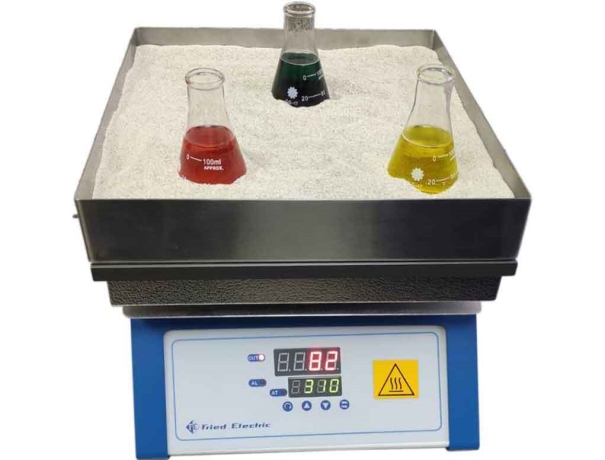MRC laboratory sand baths with variable temperature control. With good evenly distributed temperature over the entire heating surface. A sand bath is used with a container filled with heated sand. The heating surface is made of aluminum. Digital sand baths with thermostatic temperature control and separate power controller for performance adjustment to the heating requirements.Laboratory sand baths are devices designed to provide uniform heat distribution using sand as the heating medium. They are commonly used for tasks requiring stable temperatures, such as heating chemicals, melting substances, and conducting experiments.
A sand bath is a simple apparatus used extensively in experiments requiring stable and uniform heat distribution. Its design consists of a heat-resistant container filled with sand, often borosilicate glass, heated to a desired temperature using a heating element underneath. The primary purpose of this setup is to offer indirect heat to another vessel, often containing the substance or reaction undergoing experimentation.

Fearures:
Even Heating Distribution
The sand bath operates on the principle of indirect heat transfer. Once heated, the sand evenly distributes heat, surrounding the secondary container placed within it. This uniformity ensures that the substance within the secondary vessel experiences consistent temperature, minimizing the risk of localized hotspots or uneven heating that could compromise the experiment's integrity.
Versatility in Experimentation
One of the key advantages of a sand bath lies in its versatility. It accommodates a wide range of vessel shapes and sizes, making it suitable for various laboratory setups. Whether using round-bottom flasks, beakers, or test tubes, the sand bath provides a stable environment for heating without direct contact between the heat source and the reaction vessel.
Insulation and Handling
The outer casing of a sand bath is typically insulated to prevent heat loss and minimize the risk of accidental burns. Despite this, caution is advised during handling, as the apparatus can retain high temperatures even after being turned off. Proper protective gear, such as heat-resistant gloves, should be worn while operating or handling the equipment.
Maintenance and Sand Selection
Regular maintenance is essential to ensure the longevity and efficiency of a sand bath. The sand should be periodically replaced to prevent contamination and maintain optimal heat conductivity. Moreover, using high-quality sand, like quartz sand or aluminum oxide, helps guarantee consistent and reliable heating performance.
Advantages
Precise Temperature Control
Sand baths allow for fine temperature adjustments, crucial for sensitive experiments.
Versatility in Laboratory Applications
From heating liquids to maintaining constant temperatures, They support a variety of scientific processes.
Safe and Uniform Heating
The sand medium ensures even heat distribution, reducing the risk of hotspots that could damage samples.
Compatibility with Various Vessels
Laboratory sand baths accommodate a range of vessel types and sizes, making them highly adaptable.
Applications of Laboratory Sand Baths
Common Uses in Laboratories
- Heating Chemicals: Ensures controlled and even heating.
- Melting Substances: Ideal for waxes, gels, and other materials.
Industries Benefiting from Sand Baths
- Pharmaceutical Industry: For formulation and testing.
- Food and Beverage Testing: Ensures accurate sample analysis.